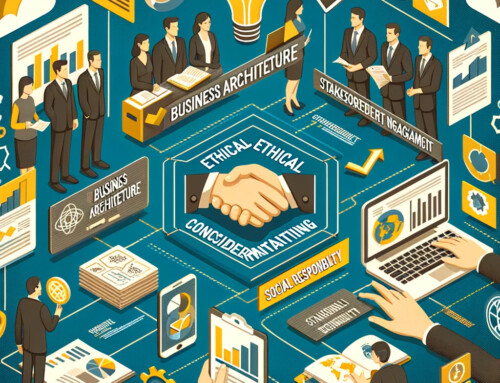
Embedding Ethics into Enterprise Architecture: Approaches for Instilling Ethical Values and Considerations Directly into Business Processes and Systems.
In today’s rapidly evolving business landscape, the integration of ethics into enterprise architecture has become imperative. As organizations navigate complex legal, social, and economic environments, the need to embed ethical considerations into the very fabric of business processes and systems is more critical than ever. This comprehensive article delves into various strategies and approaches for instilling ethical values directly into enterprise architecture, ensuring that businesses not only thrive but also contribute positively to society and the environment.
Embedding Ethics into Enterprise Architecture
- Understanding the Interplay between Ethics and Enterprise Architecture
Enterprise architecture (EA) is a strategic planning process that aligns business and IT infrastructure to achieve long-term goals. Integrating ethics into EA involves understanding the mutual influence these elements have on each other. Ethical considerations in EA encompass data privacy, equitable AI use, sustainable practices, and corporate social responsibility. For example, the European Union’s General Data Protection Regulation (GDPR) has reshaped how organizations architect their data handling processes, emphasizing privacy and consent.
- Establishing a Framework for Ethical Decision-Making
A foundational step in embedding ethics is the development of a framework for ethical decision-making. This framework should be rooted in the organization’s core values and guide all business processes and decisions. One such model is the Ethical Decision-Making Model proposed by the Josephson Institute, which emphasizes clarity, consistency, and moral integrity. By integrating this framework into EA, companies can ensure consistent ethical practices across all departments.
- Ethical Leadership and Culture
Leadership plays a pivotal role in driving ethical practices within an enterprise architecture. Ethical leaders set the tone for the organization, creating a culture where ethical considerations are paramount. A study by the Ethisphere Institute found that companies with strong ethical cultures outperform others by up to 10%. Leaders must embody and promote ethical values, ensuring these are reflected in every aspect of the organization’s architecture and processes.
- Embedding Ethics in Technology Design and Deployment
As technology becomes integral to business processes, ensuring ethical design and deployment is crucial. This includes addressing issues like algorithmic bias, data privacy, and the ethical use of AI. For instance, IBM’s AI Ethics Board oversees ethical AI deployment, focusing on fairness, transparency, and accountability. Embedding ethical considerations in the design phase ensures that technology solutions align with the organization’s ethical standards.
- Training and Awareness Programs
Implementing training and awareness programs is vital for instilling ethical values among employees. These programs should cover ethical principles, data protection laws, and specific ethical issues related to the organization’s industry. For example, Deloitte offers an Ethics & Compliance program, which educates employees on ethical decision-making and legal compliance. Regular training ensures that employees are aware of and can navigate ethical dilemmas.
- Ethical Auditing and Compliance Monitoring
Regular auditing and compliance monitoring are essential for ensuring that ethical standards are met consistently. This involves evaluating business processes, IT systems, and data handling practices against ethical benchmarks and regulatory requirements. For example, Salesforce conducts regular ethical audits of its software to identify and mitigate potential ethical risks. Such audits help in maintaining transparency and accountability in enterprise operations.
- Stakeholder Engagement and Ethical Impact Assessment
Stakeholder engagement is crucial in understanding the ethical implications of business decisions. Engaging with customers, employees, suppliers, and the community can provide diverse perspectives on ethical matters. Conducting an Ethical Impact Assessment, similar to an Environmental Impact Assessment, can reveal the potential ethical consequences of business initiatives. For instance, Microsoft’s AI for Earth program involves stakeholders in assessing the ethical impact of AI projects on environmental sustainability.
- Sustainable Practices and Corporate Social Responsibility
Incorporating sustainable practices into EA aligns business operations with broader social and environmental responsibilities. This involves adopting green technologies, reducing carbon footprints, and ensuring fair labor practices. Unilever’s Sustainable Living Plan is an excellent example of integrating sustainability into every aspect of business operations, from supply chain management to product development.
- Data Ethics and Privacy
With the increasing centrality of data in business operations, data ethics has become a critical component of EA. Organizations must ensure the ethical collection, storage, and use of data, respecting privacy and confidentiality. For instance, Apple’s commitment to user privacy, even at the cost of law enforcement requests, demonstrates a strong stance on data ethics.
- Continuous Improvement and Adaptation
Finally, embedding ethics into enterprise architecture is an ongoing process. Organizations must continuously evaluate and adapt their ethical practices in response to new challenges and evolving societal standards. This requires a commitment to lifelong learning, innovation, and responsiveness to ethical dilemmas as they arise.
Embedding ethics into enterprise architecture is not just a moral imperative but a strategic necessity in today’s complex business environment. By integrating ethical values into every aspect of business processes and systems, organizations can build trust, foster long-term sustainability, and create a positive impact on society. The approaches discussed, ranging from ethical frameworks and leadership to technology design and stakeholder engagement, provide a comprehensive roadmap for organizations seeking to align their enterprise architecture with ethical principles. As businesses continue to evolve, the commitment to ethical enterprise architecture will be a key differentiator in achieving success and societal contribution.


